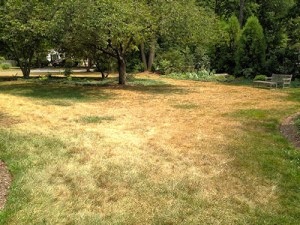The Lawn During Drought: Green or Brown?

July, 2012 has officially gone into the record books as the hottest month in U.S. history, and many areas of the nation are also experiencing very serious droughts. For homeowners with lawns, the decision must be made: water the grass to keep it green, or let it go dormant. It can be very hard to watch a lush, green lawn turn brown, but from an environmental point of view, letting a lawn go dormant may be the thing to do.
Dormant Is Not Dead
During the hot summer months, even in periods of normal rainfall, lawns usually require some supplemental irrigation to keep them healthy and green. They also require frequent fertilization and almost constant maintenance in the form of mowing. Each of these things can take a toll environmentally: Watering uses tremendous amounts of valuable water resources, fertilizing (and associated herbicides and pesticides) are often made from toxic chemicals and non-renewable fossil fuels, and mowing is usually done with some type of gas-powered equipment, which emits air pollution and climate-changing gases at levels many times that of an automobile.When the clouds dry up and cause drought-like conditions, the need for water increases exponentially. Most grass lawns require about an inch of water a week to stay healthy. If all of that water is coming from irrigation (sprinklers), that quickly adds up to thousands, even tens of thousands, of gallons of water.
What would happen if we just let nature take its course, and leave the sprinklers off? In time, the grass plants will go dormant, slowly losing its green color and taking on a brown, almost dead-like, appearance. Luckily, grasses are well-adapted to periods of low moisture. Depending on the overall health of the grass, a lawn can go dormant for quite awhile, up to a month.
Dormant Defined

Excessive Drought: When to Water
Most common turf grasses can remain in a dormant state for three or four weeks without dying. During this period, you can leave the lawn alone without too much worry. After about a month of no rain, the grass exhausts its supply of moisture which can lead to the death of the plant. It is suggested that water be added to a grass lawn after 4 weeks to re-hydrate the grass. Not a lot of water is needed at this point, just enough to keep the plants alive. Water the soil enough to soak the soil down about 5 inches, where it will be taken up by the grass' roots.This 'emergency watering' will usually not green up the grass; it's simply giving enough water to the grass to keep it from dying. A dead lawn will not come back from drought; it will have to be reseeded, which will require much more work, energy, and water than a little water CPR during drought conditions.
Mowing
Contrary to how it might look, a brown dormant lawn is a normal result of hot, dry weather. Make sure the grass is healthy during normal moisture conditions so that when conditions do get dry, it will be better prepared to ride it out until it rains. Raising the level on the lawnmower will help the grass stay healthy. Cut grass at the highest mow level possible with a sharp blade when it's dry, to reduce stress on the grass. Mowing during the cooler times of the day will also help the grass cope.
If the grass is really brown and not growing at all, reduce or stop mowing altogether. This will also save time and reduce the use of gasoline.
Fertilizing
A dormant lawn doesn't require as much nutrition as one that is green and actively growing. The grass is almost in a hibernation state during dormancy, and not taking in very many nutrients. Following a normal fertilizing routine or schedule during dormancy can actually cause injury to the 'sleeping' grass. This reduction in fertilizing will obviously save some money, which is not a bad thing at all.Weeds
There are many weeds that thrive much better under dry conditions than grasses due to their super-long tap roots that can store lots of water. If weeds start to appear in a dormant lawn, pull them manually or, if necessary, spot-treat them with a weed killer. Applying weed killing products to an entire lawn will only stress the dormant grass even more.Keep Off the Grass!
A dormant lawn gives the grouchy homeowner a good excuse to yell at the neighbor kids to stay off the lawn: Heavy foot traffic, playing, or pet use can damage the grass plants and make it harder for them to repair themselves and bounce back when the moisture returns.When the Grass Just Has to Be Green
Some homeowners simply can't stand to see a lawn turn brown, even if it's not actually dying. A lawn can be kept green during droughts, but it's going to be costly. As mentioned earlier, a lawn needs about an inch of moisture a week to stay green and growing. For best results, water less frequently and more deeply; add half to three-quarters inch of water, every 4 or 5 days. A rain gauge (or simply a tin can) can help monitor the amount of water irrigated into the lawn. Since so much watering is already occurring, it makes sense to water smartly and efficiently to get the most out of it, without overwatering.Irrgating a lawn should be done the early morning when the sun is low and temperatures are lower. This allows more water to soak into the soil and not evaporate off. Watering at night, especially in humidity, can lead to fungus problems in an already compromised lawn.
It's important to remember that if the lawn is being watered regularly, it will need its typical normal fertilizing. A slow-release fertilizer is better, as it will gradually add nutrients to the grass and not 'shock' it all at once. A well-watered lawn will also need more regular mowings.
Overview
Any homeowner concerned with the health of the natural environment should be willing to let their lawn go dormant. It's important to keep track of rainfall, however, to avoid a complete die-off of grass by doing infrequent, deep watering after 4 weeks without moisture.For more information on how to have a more eco-friendly lawn, click here.
For tips on conserving water outdoors any time of the year, click here.
comments powered by Disqus



































































